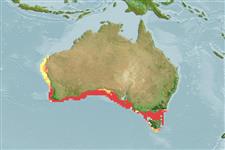Elasmobranchii (tubarões e raias) (sharks and rays) >
Carcharhiniformes (Ground sharks) >
Triakidae (Houndsharks) > Galeorhininae
Etymology: Furgaleus: fur, Latin for thief (Whitley said “‘shark’ or villain”); galeus, Greek for weasel, an ancient name for sharks perhaps alluding to what some may have perceived as a weasel-like body or pointed snout [replacement name for Fur Whitley 1943, preoccupied by Fur Jones 1940 in Diptera]. (See ETYFish); macki: In honor of British-born ichthyologist-ornithologist George Mack (1899-1963), National Museum, Melbourne, Australia. (See ETYFish).
More on author: Whitley.
Environment: milieu / climate zone / depth range / distribution range
Ecologia
marinhas demersal; intervalo de profundidade ? - 220 m (Ref. 6871). Temperate; 21°S - 45°S
Eastern Indian Ocean: southern Australia.
Length at first maturity / Tamanho / Peso / Idade
Maturity: Lm 112.0, range 120 - ? cm
Max length : 160 cm TL macho/indeterminado; (Ref. 6871); peso máx. Publicado: 12.9 kg (Ref. 6390); Idade máx. registada: 12 anos (Ref. 35585)
Found on the continental shelf, commonly on rock bottom, seaweed and kelp beds. Feeds on octopi, squid, bony fishes and lobsters. Peanut worms and seagrass are also included in their diet (Ref. 6390). Ovoviviparous, with 5-24 in a litter (Ref. 6871). Young are 20-25 cm long at birth (Ref. 13840, 244). Marketed fresh for human consumption.
Ovoviviparous but aplacental. Stock sex ratio is 1:1 (Ref. 13839). Gives birth in spring or early autumn (Ref. 6871). Litter size is 5-24 (Ref. 6871). In the Western Australian population, ovulation and early pregnancy take place between January and March. Gestation period probably lasts for 9-12 months. Each female probably does not breed every year.
Compagno, L.J.V., 1984. FAO Species Catalogue. Vol. 4. Sharks of the world. An annotated and illustrated catalogue of shark species known to date. Part 2 - Carcharhiniformes. FAO Fish. Synop. 125(4/2):251-655. Rome: FAO. (Ref. 244)
Categoria na Lista Vermelha da IUCN (Ref. 130435)
Utilização humana
Pescarias: espécies comerciais
Mais informação
ReferênciasAquaculturaPerfil para aquaculturaEstirpesGenéticaElectrophoresesHereditariedadeDoençasProcessamentoNutrientsMass conversion
ColaboradoresFotografiasStamps, Coins Misc.SonsCiguateraVelocidadeTipo de nataçãoÁrea branquialOutras referênciasCérebrosVisão
Ferramentas
Relatórios especiais
Descarregue XML
Fontes da internet
Estimates based on models
Preferred temperature (Ref.
123201): 14 - 18.2, mean 16 °C (based on 136 cells).
Phylogenetic diversity index (Ref.
82804): PD
50 = 1.0000 [Uniqueness, from 0.5 = low to 2.0 = high].
Bayesian length-weight: a=0.00427 (0.00183 - 0.00992), b=3.04 (2.83 - 3.25), in cm total length, based on LWR estimates for this (Sub)family-body shape (Ref.
93245).
Nível Trófico (Ref.
69278): 3.8 ±0.41 se; based on food items.
Generation time: 3.8 ( na - na) years. Estimated as median ln(3)/K based on 1
growth studies.
Resiliência (Ref.
120179): Muito baixo, tempo mínimo de duplicação da população maior que 14 anos (K=.29-0.42; tmax=11.5; Fec=5).
Fishing Vulnerability (Ref.
59153): High vulnerability (58 of 100).
